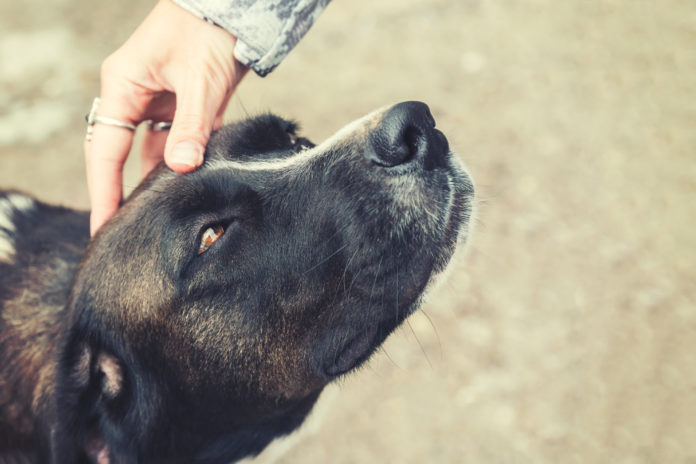Most dogs are active and love to play and run. But injuries can happen, and without proper attention, they can cause problems down the road. CranioSacral Therapy can help prevent these problems by balancing your dog from head to tail.
Dogs love to play, run, jump and chase things. Unfortunately, at some point in their active lives, they’ll experience an injury of some kind, whether it’s from rough play with another dog, or an accident such as landing incorrectly after chasing a ball. No matter how it happens, any injury will have an impact on a dog’s soft tissues, muscles, tendons and ligaments, and on his bone structure, specifically in his hind end, head and neck. This is where CranioSacral Therapy comes in.
Why CranioSacral?
At times, injuries get dismissed because the dog will get up and shake it off, and seems okay afterwards. However, these accidents and injuries create compensation patterns over time. This contributes to the dog using his body in an out-of-balanced state, and that affects his movement and biomechanics, and puts unnatural stress on his joints and an even on his behavior.
Even if the dog seems fine after an injury, it’s important to get him some therapy to avoid future problems such as joint or hip issues, especially as he ages. One therapy that has been showing successful results by restoring musculoskeletal balance and having a positive impact on dogs with behavioral problems is CranioSacral. This therapy treats the whole body from head to tail, and not just the site of the injury.
A short history of CranioSacral Therapy
CranioSacral Therapy for humans originated in the early 1900s and was the brainchild of an osteopath named William Sutherland. It was originally called Cranial Osteopathy, but in the 1980s, Dr. John Upledger coined the name CranioSacral Therapy. In 2002, I adapted the practice of CranioSacral to dogs and horses.
What exactly is it?
The traditional foundation and focus of CranioSacral Therapy in treatment includes the cranium/head (which is made up of 26 individual bones in the adult dog; puppy craniums have more bones at birth), the spine and sacrum. However, treatment is not limited to just these areas, since the whole body is connected.
What’s unique about dogs is that their craniums/heads come in different shapes and sizes due to the wide variety of breeds:
- Dolichocephalic skull, long snout – e.g. Salukis and greyhounds
- Mesocephalic skull, middle snout size – e.g. golden/Labrador retrievers and beagles
- Brachycephalic skull, short snout – e.g. pugs and boxers
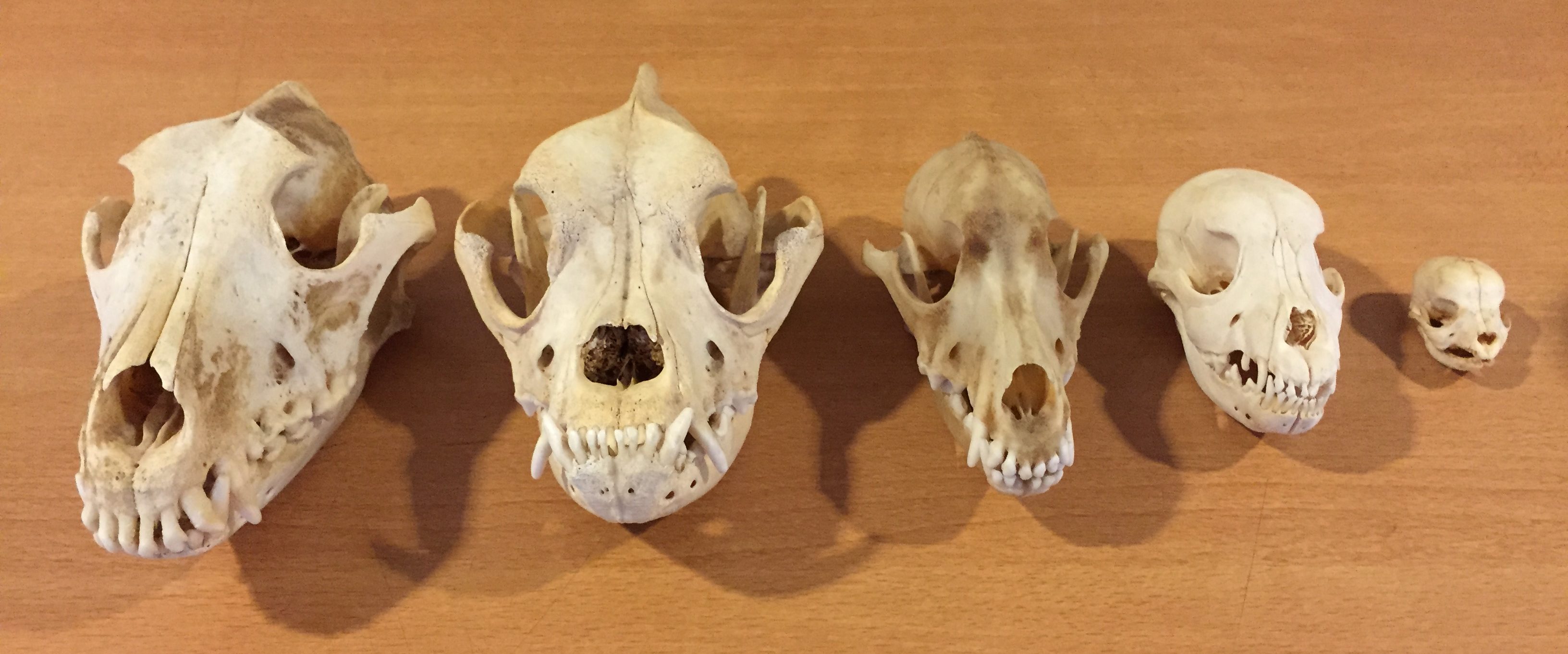
Dog skulls come in a wide variety of shapes and sizes.
What’s unique about dogs is that their craniums/heads come in different shapes and sizes due to the wide variety of breeds.
Regardless of the varying shapes and sizes (see photo above), all dog skulls have 26 individual bones. As mentioned before, puppy skulls have more individual bones at birth, which can make things more complex when an injury occurs to a pup’s head early in life.
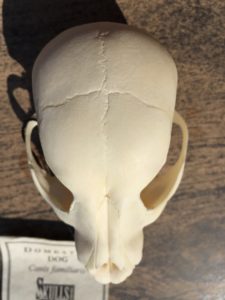
Each of the individual bones in the skull/cranium meet at what are called “sutures” (see photo at right). Sutures act like joints between the individual bones in the skull and are designed to absorb shock when an injury occurs, and to lessen the possibility of fracture upon impact.
What are the benefits?
CranioSacral Therapy is highly effective at treating both acute and chronic injuries in dogs. It is also very beneficial for keeping dogs in musculoskeletal balance, which can play a vital role in joint and skeletal health; keep their bodies flexible and mobile as they get older; and help avoid muscle atrophy, which occurs when compensation patterns are present.
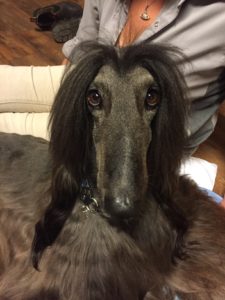
CranioSacral Therapy has also proven to be very successful in treating the following canine conditions and situations:
- Hip dysplasia
- Hind end injuries/lameness/paralysis
- Cruciate ligament injuries
- Head injuries/traumas
- Spinal injuries
- Behavioral problems – e.g. aggression, spookiness, fear, nervousness, separation anxiety, noise phobia
- Training problems
- Blocked tear ducts
- Breathing issues
- Post spay/neutering surgery
- Pre/post surgery
- Seizures
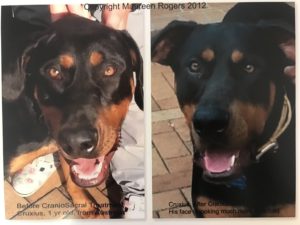
The practice of CranioSacral Therapy
What makes CranioSacral unique is that it’s one of the only therapies that focuses on treating the individual bones of the head with the whole body, which brings back balance from the head to the tail.
Specific hands-on techniques include light and gentle contact to release individual cranial bones, soft tissue/muscle tightness, and adhesions on the skeletal structure.
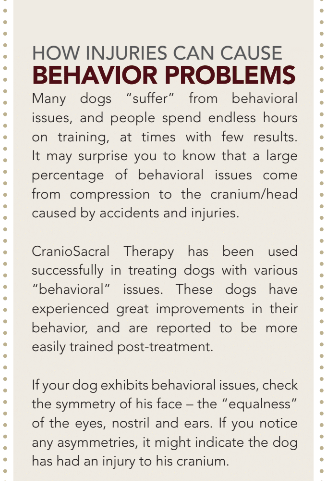
A hands-on treatment usually takes about 45 minutes to an hour. The length of the treatment is dictated by the dog’s size, and the number of treatments necessary will depend on his individual problem. In general, three to five treatments are needed, although some dogs may require more since each case is unique. It’s important to work with an educated CranioSacral practitioner who can assess your dog, including his posture, biomechanics/ movement and behavior, while getting a history of the problem from you.
Specific hands-on techniques include light and gentle contact to release individual cranial bones, soft tissue/muscle tightness, and adhesions on the skeletal structure.
A little therapy can go a long way and using CranioSacral to keep your dog in balance will benefit him physically as well as mentally and emotionally, helping him recover from any injury and making the impact of aging more comfortable!
For more information on CranioSacral Therapy for dogs, visit equinecraniosacral.com.
How injuries can cause behavior problems
Many dogs “suffer” from behavioral issues, and people spend endless hours on training, at times with few results. It may surprise you to know that a large percentage of behavioral issues come from compression to the cranium/head caused by accidents and injuries.
CranioSacral Therapy has been used successfully in treating dogs with various “behavioral” issues. These dogs have experienced great improvements in their behavior, and are reported to more easily trained post-treatment.
If your dog exhibits behavioral issues, check the symmetry of his face — the “equalness” of the eyes, nostril and ears. If you notice any asymmetries, it indicate the dog has had an injury to his cranium.

